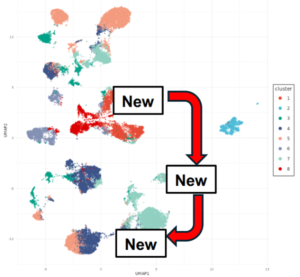Advantage and Core Benefit
- Visually estimates patient pathophysiology and characteristics in the acute critical care setting without increasing workload.
- Displays historical data for the corresponding phenotype, such as mortality rates and treatment response rates.
- Contributes to improved survival rates by enabling early identification of high-risk patients and appropriate therapeutic intervention.
- Future scalability for application to various other diseases, such as sepsis and anaphylaxis.
 |
Background and Technology
In acute critical care, rapid and accurate assessment of pathophysiology and determination of a treatment strategy are crucial. However, in blunt trauma cases, such as traffic accidents, injuries often span multiple organs, and the patient’s condition changes over time, making judgment difficult even for experienced physicians. Conventional trauma scoring systems used to estimate mortality from patient data, such as the Injury Severity Score (ISS) and the Trauma and Injury Severity Score (TRISS), were primarily intended for post-hoc analysis (e.g., quality of care assessment, epidemiological research) and had limitations in functioning as a guide for real-time prognostic prediction or selecting optimal treatments for individual patients.
To address this challenge, a research group led by Dr. Tachino at the University of Osaka has developed a method to classify patients by trauma phenotypes. They analyzed a large-scale trauma dataset (JTDB: Japan Trauma Data Bank) involving over 70,000 patients and successfully categorized them into eight distinct types using machine learning (silhouette analysis). This technology rapidly identifies patients with ultra-high-risk phenotypes—where mortality rates reach approximately 50%—using only 14 basic clinical parameters obtained shortly after transport. This ultra-high-risk phenotype is proved to be characterized by excessive inflammatory responses and blood coagulation abnormalities by proteome analysis, suggesting the potential efficacy of targeted therapies using anti-inflammatory agents and anticoagulants. Furthermore, software that visually tracks patient phenotype transitions in real-time based on changes in vital signs over time was developed (see figure above), enabling immediate response to changes in patient condition.
By precisely stratifying patients based on data rather than relying on rules of thumb, this technology holds great promise for developing new treatment strategies and applying it to drug development targeting specific phenotypes.
Data
- Classified phenotypes into eight types; identified that phenotypes with high mortality rates share common upregulation of genes related to inflammation and blood coagulation via proteomics analysis, providing reference for treatment strategy formulation (Press Release 1)
- Identified phenotypes responsive to tranexamic acid (antifibrinolytic agent) use / phenotypes associated with increased mortality (Press Release 2)
Current Stage and Next Steps
- Prototype demo software “Trauma Vis” completed.
- Analysis for each phenotype is ongoing.
- Development of automated input system using voice/image via generative AI. (planning stage)
- Exploration of applicability beyond trauma for this technology concept. (planning stage)
Patent & Publication
- Patent pending from the University of Osaka (JP 2023-108530, WO/2025/023226)
- Press Release1:https://resou.osaka-u.ac.jp/en/research/2022/20220810_1
Critical Care, volume 26, Article number: 241 (2022), https://doi.org/10.1186/s13054-022-04103-z - Press Release2:https://resou.osaka-u.ac.jp/en/research/2024/20240404_2
Critical Care, volume 28, Article number: 89 (2024), https://doi.org/10.1186/s13054-024-04871-w
Researcher
Jotaro Tachino, PhD (Assistant Professor, Department of Traumatology and Acute Critical Medicine, The University of Osaka Graduate School of Medicine)
Researcher Web: https://researchmap.jp/jotarotachino?lang=en
Expectations
The University of Osaka is seeking companies to co-develop a patient stratification system based on this technology under license. Examples of the development are:
1) Integration into Electronic Medical Records (EMR),
2) Development of an automatic AIS (Abbreviated Injury Scale) input system using voice input or CT image processing,
3) Expansion of applicable diseases through joint research.
Disclosure of unpublished data, etc., is possible upon concluding a non-disclosure agreement (NDA) with the University of Osaka, and meetings with the inventor can also be arranged.
Project ID:KJ-04712


